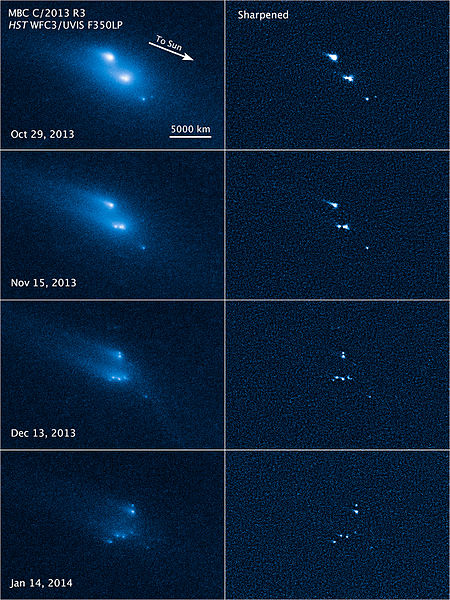3200 Phaethon, provisionally designated 1983 TB, is an active Apollo asteroid with an orbit that brings it closer to the Sun than any other named asteroid. For this reason, it was named after the Greek myth of Phaëthon, son of the sun god Helios. It is 5.8 km (3.6 mi) in diameter and is the parent body of the Geminids meteor shower of mid-December. With an observation arc of 35+ years, it has a very well determined orbit. The 2017 Earth approach distance of about 10 million km was known with an accuracy of ±700 m.
Phaethon's dust ejection is likely caused by a mechanism similar to how mud in a dry lake bottom cracks from heat
Phaethon imaged on December 25, 2010, with the 37-cm f/14 Rigel telescope at Winer Observatory by Marco Langbroek
Active asteroids are small Solar System bodies that have asteroid-like orbits but show comet-like visual characteristics. That is, they show a coma, tail, or other visual evidence of mass-loss, but their orbits remain within Jupiter's orbit. These bodies were originally designated main-belt comets (MBCs) in 2006 by astronomers David Jewitt and Henry Hsieh, but this name implies they are necessarily icy in composition like a comet and that they only exist within the main-belt, whereas the growing population of active asteroids shows that this is not always the case.
Asteroid 596 Scheila displaying a comet-like appearance on 12 December 2010
Dust ejecta and tail from the aftermath of the Double Asteroid Redirection Test's impact on the asteroid moon Dimorphos, as seen by the Southern Astrophysical Research Telescope in 2022
Disintegration of asteroid P/2013 R3 observed by the Hubble Space Telescope (6 March 2014).
Asteroid 101955 Bennu seen ejecting particles on January 6, 2019, in images taken by the OSIRIS-REx spacecraft






